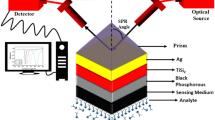Abstract
A surface plasmon resonance–based biosensor for the detection of chikungunya virus has been proposed in this article. The structure of the sensor is based on the Kretschmann configuration, which includes a BK7 prism, silver (Ag) metal, titanium dioxide (TiO2), a perovskite material (BaTiO3), and a heterostructure 2D nanomaterial (blue phosphorene/tungsten disulfide; BP/WS2). The surface of the 2D heterostructure material is employed for the detection of the analyte, aiming to investigating the alterations in refractive index. Using the transfer matrix method (TMM), the reflectivity of the proposed sensor is analyzed numerically. The investigation also explores the enhancement of sensitivity by considering variations in number and thickness of layers. To confirm the location of resonance angle and substantiate the ultrahigh sensitivity, an examination of the electric field intensity enhancement factor and normalized electric field distribution has been also conducted. The optimization of parameters for the proposed sensor revealed that platelets and plasma cells have a maximum sensitivity of 365°/RIU and 152°/RIU, figures of merit of 94.147 and 73.98, and detection accuracy of 0.2579 and 0.4859 deg−1. The normalized electric field plot suggests a penetration depth of the order of 102 nm which enables long-range sensing and strong field-analyte interaction. The sensor offers high sensitivity and stability and may find useful applications in biomedical industries.






Similar content being viewed by others
Data Availability
No datasets were generated or analyzed during the current study.
References
Sharma AK, Pandey AK, Kaur B (2018) Opt Fiber Technol 43:20
Singh S, Singh PK, Umar A, Lohia P, Albargi H, Castañeda L, Dwivedi DK (2020) Micromachines (Basel) 11
Yee SS, nter Gauglitz G (1999) Surface plasmon resonance sensors: review
Homola J, Yee SS, Gauglitz G (1999) Sens Actuators B Chem 54:3
Byun KM, Kim SJ, Kim D (2007) Appl Opt 46:5703
Asaduzzaman S, Arif MFH, Ahmed K, Dhar P (2015) IEEE International WIE Conference on Electrical and Computer Engineering, WIECON-ECE 2015(1):151 (2016)
Haque MA, Rahad R, Faruque Md O, Mobassir Md S, Sagor RH (2023) Sens Biosens Res 100618
Yadav S, Lohia P, Dwivedi DK (2023) Plasmonics 18:1753
Fan X, White IM, Shopova SI, Zhu H, Suter JD, Sun Y (2008) Anal Chim Acta 620:8
Homola J (2008) Chem Rev 108:462
Mishra AC, Sharma AK, Lohia P, Dwivedi DK (2023) Plasmonics
Umar A, Singh S, Yadav S, Mishra AC, Alhamami MA (2022) 1655
Tamada K, Li X, Wulandari P, Nagahiro T, Michioka K, Toma M, Toma K, Obara D, Nakada T, Hayashi T, Ikezoe Y, Hara M, Katano S, Uehara Y, Kimura Y, Niwano M, Tero R, Okamoto K, Geddes CDD, Geddes CD (2012) Rev Plasmonics 2010
Peters K (2011) Smart Mater Struct 20
Suvarnaphaet P, Pechprasarn S (2017) Sensors (Switzerland) 17
Abdulhalim I, Zourob M, Lakhtakia A (2008) Electromagnetics 28:214
Singh S, Mishra AC, Singh S, Lohia P, Dwivedi DK, Yadav S (2023) Optik (Stuttg) 289
Gan S, Zhao Y, Dai X, Xiang Y (2019) Results Phys 13
Shavanova K, Bakakina Y, Burkova I, Shtepliuk I, Viter R, Ubelis A, Beni V, Starodub N, Yakimova R, Khranovskyy V (2016) Sensors (Switzerland) 16:1
Dahmen C, Schmidt B, Von Plessen G (2007) Nano Lett 7:318
Wang JX, Sun XW, Wei A, Lei Y, Cai XP, Li CM, Dong ZL (2006) Appl Phys Lett 88
Karki B, Uniyal A, Chauhan B, Pal A (2022) J Comput Electron 21:445
Srivastava A, Das R, Prajapati YK (2020) IET Optoelectron 14:256
Sharma AK, Pandey AK (2018) IEEE Photonics Technol Lett 30:595
Peng Q, Wang Z, Sa B, Wu B, Sun Z (2016) Sci Rep 6
Srivastava A, Prajapati YK (2019) Photonic Sensors 9:284
Kumar S, Yadav A, Malomed BA (2023) Front Mater 10
Bai J, Zhou B (2014) Chem Rev 114:10131
Karki B, Ramya KC, Sandhya Devi RS, Srivastava V, Pal A (2022) Opt Quantum Electron 54:1
Srivastava S, Singh S, Mishra AC, Lohia P, Dwivedi DK (2023) Plasmonics
Wang Q, Niu LY, Jing JY, Zhao WM (2020) Opt Laser Technol 124:105899
Karki B, Pal A, Singh Y, Sharma S (2022) Opt Commun 508:127616
Cai W, Fu C, Gao J, Guo Q, Deng X, Zhang C (2011) Physica B Condens Matter 406:3583
Rakic´ AD, Rakic´ R, Djuriš AB, Elazar JM, Majewski ML (1998) Optical properties of metallic films for vertical-cavity optoelectronic devices
Yupapin P, Trabelsi Y, Vigneswaran D, Taya SA, Daher MG, Colak I (2022) Plasmonics
Mishra AC, Singh PK, Lohia P, Dwivedi DK (2019) Sens Lett 17:1
Mishra AC, Dandapat K, Tripathi SM, Lohia P, Dwivedi DK (2020) J Opt Commun
Karki B, Uniyal A, Sharma T, Pal A (2022)
Pal A, Jha A (2021) Optik (Stuttg) 231:166378
Yadav A, Kumar A, Sharan P (2022) J Opt Soc Am B 39:200
Singh S, Sharma AK, Lohia P, Dwivedi DK, Kumar V, Singh PK (2023) Physica Scripta 98
Kashyap R, Baruah UR, Gogoi A, Mondal B (2023) Plasmonics 18:1679
Funding
This work was funded by the Researchers Supporting Project (Number RSP2024R161) King Saud University, Riyadh, Saudi Arabia.
Author information
Authors and Affiliations
Contributions
Yashaswini Singh wrote original manuscript and analyzed the results, Adarsh Chandra Mishra and Sapana Yadav provided software support, conceptualized and reviewed the work, while Pooja Lohia, M. Khalid Hossain, D.K. Dwivedi and Gaber E. Eldesoky reviewed, edited and supervised the work.
Corresponding author
Ethics declarations
Ethics Approval
This is a theoretical analysis, so no ethical authorization is required.
Competing Interests
The authors declare no competing interests.
Additional information
Publisher's Note
Springer Nature remains neutral with regard to jurisdictional claims in published maps and institutional affiliations.
Rights and permissions
Springer Nature or its licensor (e.g. a society or other partner) holds exclusive rights to this article under a publishing agreement with the author(s) or other rightsholder(s); author self-archiving of the accepted manuscript version of this article is solely governed by the terms of such publishing agreement and applicable law.
About this article
Cite this article
Singh, Y., Dwivedi, D.K., Lohia, P. et al. Highly Sensitive Plasmonic Biosensor for the Detection of Chikungunya Virus Employing TiO2 and BP/WS2 Heterostructure. Plasmonics (2024). https://doi.org/10.1007/s11468-024-02242-3
Received:
Accepted:
Published:
DOI: https://doi.org/10.1007/s11468-024-02242-3




